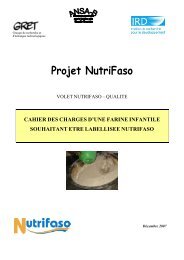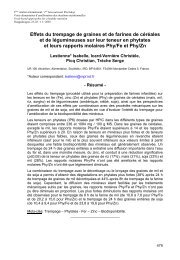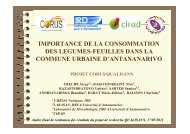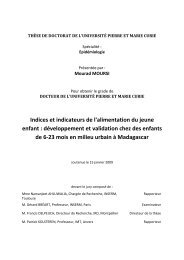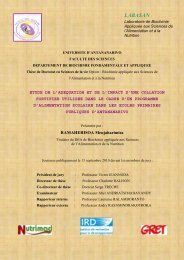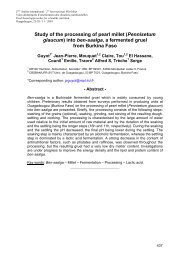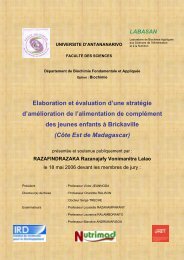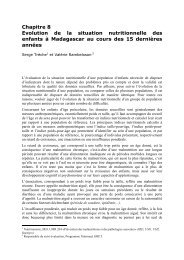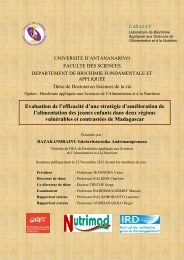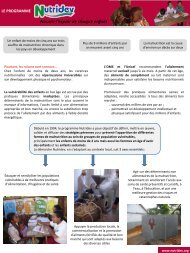THESE UNIQUE El Hassane Kéhien-Piho TOU - Nutridev
THESE UNIQUE El Hassane Kéhien-Piho TOU - Nutridev
THESE UNIQUE El Hassane Kéhien-Piho TOU - Nutridev
Create successful ePaper yourself
Turn your PDF publications into a flip-book with our unique Google optimized e-Paper software.
International Journal of Food Microbiology 106 (2006) 52 – 60<br />
www.elsevier.com/locate/ijfoodmicro<br />
Study through surveys and fermentation kinetics of the traditional<br />
processing of pearl millet (Pennisetum glaucum) into ben-saalga,<br />
a fermented gruel from Burkina Faso<br />
E.H. Tou a,b , J.P. Guyot b, *, C. Mouquet-Rivier b , I. Rochette b , E. Counil b , A.S. Traoré a ,S.Trèche b<br />
a Université de Ouagadougou/UFR-SVT/CRSBAN, Burkina Faso<br />
b UR106, ?Nutrition, Alimentation, SociétésX, Institut de Recherche pour le Développement (IRD), BP 64501, 34394 Montpellier, France<br />
Received 23 June 2004; received in revised form 19 February 2005; accepted 21 May 2005<br />
Abstract<br />
Traditional cereal-based fermented foods are frequently used as complementary foods for infants and young children in Africa. This is the case<br />
for ben-saalga, a popular fermented gruel produced from pearl millet (Pennisetum glaucum) in Burkina Faso. Detailed knowledge of traditional<br />
processing is a prerequisite for investigating ways to improve both the nutritional and sanitary qualities of the corresponding foodstuff. In this<br />
work, the traditional processing of pearl millet into ben-saalga was investigated in 24 production units, and fermentation kinetics were studied in<br />
pilot scale experiments. Processing steps include: washing (optional), soaking of the grains (first fermentation step), grinding and sieving of the<br />
wet flour, settling (second fermentation step), and cooking. The soaking step was mainly characterized by alcoholic fermentation whereas lactic<br />
acid fermentation occurred during the settling step. Fermentation kinetics during settling indicates a temporal variation of metabolic activity.<br />
Initially, both homofermentative and heterofermentative pathways were simultaneously active, and later only a homofermentative pathway was<br />
active. The paste produced at the end of settling had a low pH (4.0T0.4) and its microflora was dominated by lactic acid bacteria (LAB) with an<br />
amylolytic LAB/LAB ratio of 12%. Sucrose disappeared in the grains during soaking but was not detected in the soaking water, whereas glucose,<br />
fructose and maltose appeared transiently. Glucose and fructose were the main substrates observed for lactic acid fermentation during the settling<br />
step; however unbalanced fermentation led to the hypothesis that starch hydrolysis products may also serve as substrates for lactic acid formation.<br />
At the end of the processing, a 75% and 83% decrease was observed in phytate (IP6) and raffinose, respectively. The sour gruel ben-saalga<br />
resulting from cooking the sour paste had inadequate nutritional characteristics with respect to infants’ and young children’s requirements; it was<br />
characterized by fluid consistency (Bostwick flow: 137 mm/30 s) and low energy density (about 30 kcal/100 g of gruel).<br />
D 2005 <strong>El</strong>sevier B.V. All rights reserved.<br />
Keywords: Lactic acid fermentation; Pearl millet; Complementary food; Phytate; a-Galactoside; Amylolytic lactic acid bacteria<br />
1. Introduction<br />
* Corresponding author.<br />
E-mail address: jpguyot@mpl.ird.fr (J.P. Guyot).<br />
Throughout Africa, fermentation is a traditional part of<br />
cereal and cassava processing. A wide range of cereal-based<br />
fermented foods exists (Tomkins et al., 1988; Hounhouigan et<br />
al., 1991; Oyewole, 1997; Blandino et al., 2003) such as ogi<br />
and mawè in Benin, kenkey in Ghana, injera in Ethiopia, potopoto<br />
in Congo, ogi and kwunu-zaki in Nigeria, uji and togwa<br />
in Tanzania, kisra in Sudan. These foods are still often used to<br />
prepare gruels for the complementary feeding of infants and<br />
young children. However, compared to the required composition<br />
of complementary food (Dewey and Brown, 2003; Lutter<br />
and Dewey, 2003), the traditional gruels have low energy and<br />
nutrient density (Lorri and Svanberg, 1994; Trèche and<br />
Mbome, 1999) and traditional methods of processing need to<br />
be changed to improve the quality of these foods.<br />
A great deal of information about processing (Kitabatake et<br />
al., 2003; Blandino et al., 2003), biochemical (Hounhouigan et<br />
al., 1993; Kingamkono et al., 1994; Svanberg and Lorri, 1997)<br />
and microbiological characteristics (Odunfa and Adeyele,<br />
1985; Nout et al., 1989; Mensah et al., 1991; Lei and Jakobsen,<br />
2004) is available on numerous traditional cassava and cerealbased<br />
fermented foods. However, only a few studies, like those<br />
on Ghanaian koko (Lei and Jakobsen, 2004) and on togwa<br />
(Kitabatake et al., 2003), are based on descriptions made from<br />
0168-1605/$ - see front matter D 2005 <strong>El</strong>sevier B.V. All rights reserved.<br />
doi:10.1016/j.ijfoodmicro.2005.05.010



